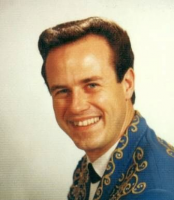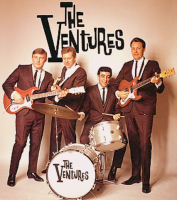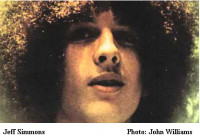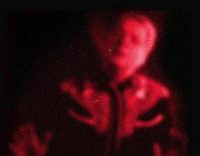
Who would have thought that a kid from Olympia WA would become one of the architects of country music’s Bakersfield Sound? Don Eugene Ulrich was born in Washington’s state Capitol on August 15th, 1941, and grew up in the adjacent town, Tumwater WA. He was the adopted son of Bill and Anne Ulrich and went by that name as a youth but would later shorten his last name to Rich. Don’s parents encouraged him to play music, going so far as to give him a home-made violin at the tender age of three. Don was a musical child prodigy. He learned the fiddle in short order and soon after picked up a guitar, also becoming proficient at the instrument in a short time. Don’s parents were confident enough of his skill to enter him in a series of local talent and variety shows.
By the age of 16, Rich had opened for a matinee performance by Elvis Presley on September 1st, 1957, at Tacoma’s Lincoln Bowl. Lincoln Bowl was an amphitheater adjacent to Lincoln High School overlooking Puget Sound. Since Presley’s performance took place next to Lincoln High School, the show saw the amphitheater full of screaming teens.
During his last year of High School, Don Rich had started playing his fiddle around the south Puget Sound region and forming a rock and roll band called the Blue Comets with drummer Greg Hawkins and pianist Steve Anderson. But Don’s love was closer to country and folk than rock and roll, so he continued playing gigs as a fiddler. One of those gigs was at Tacoma’s Steve’s Gay ’90s, where he would catch his first break-one that would change his life forever. Former Bakersfield CA musician Buck Owens was doing a stint at Tacoma radio station KAYE at the time. Rich was playing at Steve’s Gay ’90s when Buck Owens walked in one night in 1958. Owens, a fiddler in his own right, had already seen Rich onstage and was taken by Rich’s talent almost immediately. After their first meeting, they soon became great friends and collaborators. Don would join Owen’s band that played around Tacoma and Seattle. Owens was also a radio and television presenter, so when Rich joined-up with Owens, he found himself doing a weekly spot on KTNT-TV 11’s BAR-K Jamboree. The show had the distinction of introducing Loretta Lynn to television with her first appearance in a talent-contest Owens held on the Bar-K Jamboree in 1960. Buck had become a local personality in and around Tacoma, but earlier, he’d worked as a session player in Hollywood. Buck played lead guitar on what is sometimes regarded as the first “Bakersfield Sound” recording, Louisiana Swing by Bud Hobbs. MGM Records released the song, and although it wasn’t a huge hit, it set the groundwork for a sound that Buck Owens, along with Merle Haggard, would primarily be responsible for beginning in the late 50s and throughout the 1960s. The “Bakersfield Sound” had slowly developed since the days of Bob Willis, but it had never caught on aside from Willis’s novel idea of conflating Swing with Country and Western.
In 1959 Buck got a significant response to his first “hit” “Second Fiddle”, which hit No. 24 on the Billboard country chart. It was soon followed by “Under Your Spell Again” that peaked at number 4 in the Billboard country charts. It wasn’t long before Owens was packed-up and ready to return to Bakersfield and it’s proximity to Columbia Records, who had signed him and would release most of the Buck Owens and The Buckaroos recordings. Buck urged Don Rich to follow him as part of his band, but Rich chose to remain in Washington and study to become a music teacher and tutor in Centralia WA, where he continued to play fiddle at local bars.
After a year, Don had a change of heart and left for Bakersfield to play fiddle in Owen’s band. Buck Owens had an even bigger hit with “Above and Beyond,” which peaked at No. 3 in 1960. The song was the first track Rich had played fiddle on. From then on, Don and Buck became practically equal collaborators, driving near and far to play gigs up and down the west coast with pick-up musicians- or as a duo- and building a reputation for the basic, honky-tonk inspired and stripped-down sound of their live performances.
The Bakersville Sound was not entirely developed until 1963 when Owens and his band released the single “Act Naturally”, a song that’s been covered by everyone from the Beatles to Mrs. Miller. to Loretta Lynn and Dwight Yoakam. Ringo Starr, who had sung the Beatles version of the song released in August, 1965 joined Buck Owens for a duet of the song in 1989. “Act Naturally” was the first recording on which Don played lead guitar. By the time Owens recorded the song, he and Rich were backed by The Buckaroos, which included Kenny Pierce on bass, Jay McDonald on steel guitar, and Willie Cantu on drums. The band was filled-out during recordings with various session members. The name The Buckaroos is thought to have been created by Merle Haggard. At the time, Haggard was also building his estimable career out of Bakersfield.
So what, exactly, is the “Bakersfield Sound“? A lot of it is based on the idea of being an outsider. This may come from the fact that a good portion of those living in and around
Bakersfield were transplants from Oklahoma, Kansas, and Northern Texas…the so-called Okies trying to escape the dustbowl of the 1930s. Many had found work in California’s San Joaquin Valley, and especially around its southern portion, where Bakersfield was a center of agriculture, cattle, and oil drilling. All were occupations Okies would already be familiar with.
The Okies had brought their traditional music and the instruments they played; fiddle, guitar, any percussion that was available whether it be banging on a tin pot or stomping on the floor. They had a prominent and deep respect for “Hillbilly Music” and what we’ve come to know as Americana. A few early practitioners of this stripped-down sound (Wynn Stewart and The Maddox Brothers and Sister Rose, for instance) were playing what would become the “Bakersfield Sound” in and around the city during the mid-50s. Not many practitioners of the pre-Bakersfield Sound found wide commercial success. At first, this was a regional sound, but within a decade, it would become a huge influence on Country Music outside it’s traditional home, Nashville TN.
The Bakersfield Sound was a direct response to what was happening in Nashville. Country artists and songs there were being produced with lavish string arrangements and prominent, soothing background choruses. The piano was included but always as an accompaniment and NEVER in the honkey-tonk style. The Hawaiian or Steel guitar was barely featured-if they were used in the first place.
+++++++++++++++++++++++++++++++++++++++++++++++++++++++++++++++++++++++
The music of Nashville had become closer to the pop music of the day than what we think of as Country and Western. Even Patsy Cline, who is almost universally considered the greatest country vocalist of all time was subjected to this kind of over-produced approach. Take a listen to “Crazy”, “Sweet Dreams” or “She’s Got You”. All are classics and can’t detract from Cline’s genius. But if we listen without the pre-conceived notion these are meant to be Country songs the only conclusion we can come to is that they represent the sound of the pop music of the 50’s. The songs wouldn’t be as wonderful, but it’s not too far a stretch to envision the production more fitting Gayle Storm or Patti Page. The Bakersfield Sound stripped away the adornment, the huge productions, the orchestration and brought in the electric guitar, pushed percussion forward and added a backbeat. What they had in effect done is created a hybrid of rock and roll.
Don Rich had found himself in the midst of this progression while playing fiddle with Buck Owens in the Northwest, but fairly soon took the guitar up in Buck’s band once he landed in Bakerfield. It was his smooth, restrained and precise playing on his Telecaster that contributed to the overall sound of The Buckaroos, and in turn with the way Country and Western Music would move toward in the 60s.
In 1963, Buckaroos bassist Kenny Pierce quit the band during a tour. Rich called in an acquaintance named Doyle Holly to replace him About a year later steel player Jay McDonald quit and was replaced by Tom Brumley. This is the classic line-up thought of as The Buckaroos. Following incarnations of the band would include many talented musicians but it was Buck’s voice, Don’s guitar that was always at the center of the band.
https://youtu.be/l22bwUnSGZ8
What followed was an incredible string of hits in the 60s and 70s that made Buck Owens and The Buckaroos not only country music favorites, but true crossover hitmen. The ‘60s saw hits like “Together Again”, “I’ve Got A Tiger by The Tail”,“My Heart (Skips A Beat)”, “Waitin’ In Your Welfare Line” and “Before You Go” which spent an incredible 17 weeks at the top of the country charts. Hit after hit seemed to flow from the band one after the other. The band was so popular that they managed to put out eight full albums in the short time between 1967 and 1971. They also played at The White House and Carnegie Hall. The Carnegie Hall recording is considered one of the best-if not the best live country album of all time.
It was the harmonies of Don and Buck, and the expert playing of Rich himself that was the cornerstone of their popularity. Don stepped out occasionally to sing, and later he went on to record two solo albums with The Buckaroos as side-projects. Don’s guitar work was becoming an inspiration not only to fans of The Bakersfield Sound, but also influenced the nascent country-rock movement that began mostly out of Los Angeles in the late 1960s. It’s early adherents were Gram Parsons, Emmylou Harris, and The Flying Burrito Brothers and later practioners like Linda Ronstadt and The Eagles picked up on the sound.In fact in 1968 Buck’s band was enough of an underground music influence to play a sold-out concert at San Francisco’s Fillmore West. Today’s most prominent player of the sound is probably Dwight Yoakam.
In 1968 Buck Owens signed on as a co-host of an amiable, corn-ball summer replacement for the popular Smothers Brothers Comedy Hour. Don Rich was made musical director of the show Hee Haw, and although the show was only planned for the summer it became such a hit that the show was continued on CBS for two more seasons and afterward went into first run syndication for another 20 years. During it’s run Don Rich appeared as a member of The Buckaroos as well as a lead performer with The Buckaroos backing him. This gave viewers a front-row seat in watching and listening to Don’s guitar picking. The Buckaroos, featuring Don’s outstanding playing continued to be a top crowd draw as well as the reigning stars of country music.
In 1969 The Buckaroos released “Who’s Gonna Mow Your Grass.” Don had complimented his usual picking style with a more dense fuzz-tone. Traditional country music fans were shocked, and some even became angry at Buck for “defacing country music” with such a blatant rock and roll techniques. Don, Buck and the band didn’t pay much attention..they didn’t have to because “Who’s Gonna Mow Your Grass?” became another big hit. It reached number one on the country charts for two weeks.
The early 1970s would continue to see hits for The Buckaroos even though eventually the only original members remaining were Buck and Don. As the power of the Bakersfield Sound was popularized and then diluted Don and Buck had their last number one hit in 1972 with the song “Made In Japan”. The two continued their personal and professional relationship. They wrote and recorded music just as they had in the early days, and in their salad days.
On July 17, 1974 Don Rich finished a few recording chores at he and Buck’s Bakersfield studio. He then set off, by motorcycle to meet his family up the coast in Morro Bay where they had been vacationing. Somewhere between his night ride from Bakersfield to Morro Bay Don’s motorcycle crashed into a lane divider and he was thrown from his bike. Don Rich suffered extensive damage and was transported to a local hospital where he was pronounced Dead On Arrival. He was only 32 years old. The cause of his accident is still a bit of a mystery, since there were no witnesses, but police at the time noted there were no skid marks before the crash, so it was likely Don accidently drove directly into the divider at a high rate of speed.
Buck Owens was devastated by the loss of his friend, his collaborator and one of the most renowned guitarists in country music history. Buck later said:
“He was like a brother, a son, and a best friend. Something I never said before, maybe I couldn’t, but I think my music life ended when he died. I carried on and existed, but the real joy and love, the real lightening and thunder is gone forever.”
Don Rich’s life may have ended that day, but his musicianship and reputation as an all-around gentleman lives on. Country musicians still try to copy his lean but precise and complicated guitar licks. He’s become a near-legendary figure among the old and newly introduced country music fans and musicians. His reach has grasped all the way into the 21st century. In a way Don Rich has achieved what he wanted to before his studies in Centralia. He is still considered the gold standard of the Bakerfield Sound guitar. History has made Don Rich the music teacher and tutor he had once set out to be.
-Dennis R. White. Sources; Don Duncan (The Tacoma News Tribune – September 2, 1957); Scott Bomar & Randy Poe, Bakersfield Sound Judgement: Pair Pick top 50 songs (Bakersfield.com, December 31, 2015); Buck Owens Brunch: The Tragic Story of Don Rich (thebigfootdiaries.blogspot.com, 2/09/2014); Rich Kienzle-“Buck Owens and The Buckaroos-A Bunch of Twangy Guitars” (Vintage Guitar Magazine, May 2007)


















